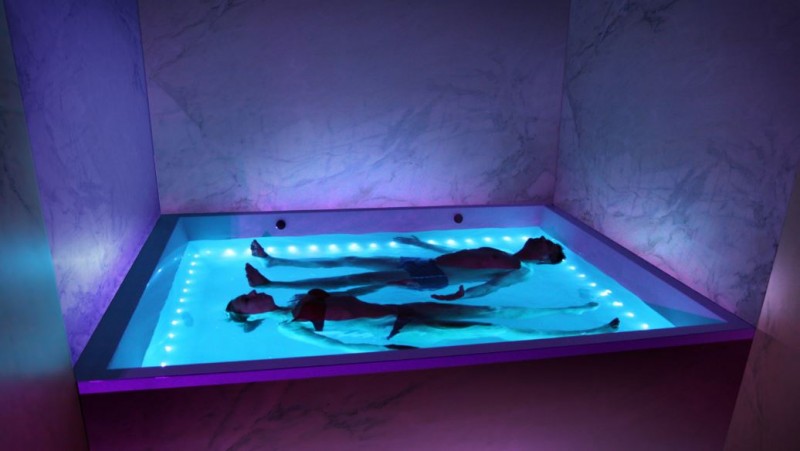
Introduction
In today's fast-paced world, finding ways to relax and rejuvenate is more important than ever. One method that has gained popularity is floating therapy, also known as sensory deprivation or floatation therapy. This article aims to delve into the world of floating therapy, exploring its benefits and how it promotes relaxation. Whether you're seeking relief from stress, muscle tension, or simply looking to enhance your overall well-being, floating therapy could be the answer you've been searching for.
1. What is Floating Therapy?
Floating therapy involves immersing oneself in a sensory deprivation tank filled with warm saltwater. The tank is designed to isolate the individual from external stimuli such as light, sound, and gravity, creating a serene and weightless environment.
2. The Science Behind Floating Therapy
Floating therapy works on the principle of reducing sensory input to the brain, inducing a deep state of relaxation. The environment inside the tank triggers the brain to produce theta waves, associated with deep meditation and relaxation.
3. Creating the Optimal Environment: Saltwater Tanks
Saltwater tanks, also known as float tanks or isolation tanks, are specifically designed to facilitate floating therapy. These tanks are filled with a carefully calibrated mixture of warm water and Epsom salt, creating a buoyant and soothing environment for the individual.
4. The Benefits of Sensory Deprivation
4.1 Stress Reduction and Relaxation
Floating therapy provides a tranquil and stress-free environment, allowing the body and mind to unwind. The absence of external distractions helps individuals achieve a deep sense of relaxation, relieving them from the pressures of daily life.
4.2 Relief from Chronic Pain
The buoyancy provided by the saltwater tank helps alleviate pressure on joints and muscles, providing relief from chronic pain conditions such as arthritis and fibromyalgia. Floating therapy promotes natural pain management by releasing endorphins and reducing inflammation.
4.3 Improved Sleep Quality
Floating therapy can be particularly beneficial for individuals suffering from sleep disorders or insomnia. The relaxation induced during a float session helps regulate sleep patterns, resulting in improved sleep quality and a more restful night.
4.4 Enhanced Mental Clarity and Creativity
The sensory deprivation experienced in the float tank allows the mind to enter a state of deep introspection, fostering mental clarity and enhancing creativity. Many individuals report heightened problem-solving abilities and improved focus after engaging in floating therapy.
5. Boosting Physical Health with Floating Therapy
5.1 Muscle Recovery and Rehabilitation
Floating therapy has been widely used in sports and athletics due to its ability to accelerate muscle recovery and aid in rehabilitation. The weightlessness inside the tank helps reduce muscle tension and enhances blood circulation, facilitating faster healing.
5.2 Alleviating Symptoms of Anxiety and Depression
Floating therapy has shown promising results in alleviating symptoms of anxiety and depression. The sensory deprivation environment triggers the release of endorphins and promotes a sense of calmness, providing relief to individuals suffering from these mental health conditions.
5.3 Lowering Blood Pressure
Regular floating therapy sessions have been associated with lowered blood pressure levels. The deep relaxation experienced during a float session helps reduce stress hormones, promoting cardiovascular health and overall well-being.
6. Who Can Benefit from Floating Therapy?
Floating therapy is suitable for a wide range of individuals, including those seeking stress relief, physical recovery, improved mental health, or simply a way to enhance their overall well-being. However, it is essential to consult with a healthcare professional if you have any underlying medical conditions or concerns.
7. Preparing for Your Floating Experience
Before your floating session, it is essential to follow certain guidelines. These may include avoiding caffeine or heavy meals, ensuring you are well-hydrated, and showering before entering the tank to remove any oils or lotions.
8. What to Expect During a Float Session
During a float session, you can expect to experience a sense of weightlessness and complete relaxation. The tank's environment will eliminate external stimuli, allowing your mind and body to enter a state of deep tranquility. The duration of a session typically ranges from 60 to 90 minutes.
9. Post-Float Integration and Self-Care
After your float session, it is important to give yourself time to reintegrate into your surroundings. Engaging in gentle stretches, practicing mindfulness, and reflecting on your experience can help prolong the benefits of floating therapy.
10. Incorporating Floating Therapy into Your Wellness Routine
Floating therapy can be a valuable addition to your wellness routine. Regular sessions can provide long-lasting benefits, promoting physical and mental well-being. Consider incorporating floating therapy into your self-care practices to enhance your overall quality of life.
11. The Future of Floating Therapy
As the awareness and popularity of floating therapy continue to grow, advancements in technology and research will likely contribute to its evolution. This may include improved sensory deprivation tank designs, enhanced relaxation techniques, and a deeper understanding of the therapeutic benefits.
Conclusion
Floating therapy offers a unique and effective way to achieve deep relaxation, promote overall well-being, and alleviate various physical and mental health conditions. By immersing oneself in a saltwater tank, individuals can experience the benefits of sensory deprivation and enjoy the rejuvenating effects it brings. Consider exploring floating therapy as a holistic approach to self-care and embark on a journey of relaxation and self-discovery.
Unveiling the Menace: Understanding the Causes and Solutions of Water Pollution
Nurturing Nutritional Practices: Cultivating a Well-Balanced Lifestyle
Reviving the Sacred Waters: The Urgent Need for Ganga and Yamuna River Conservation